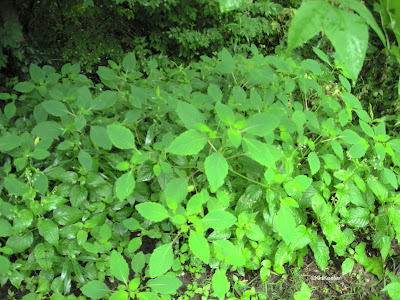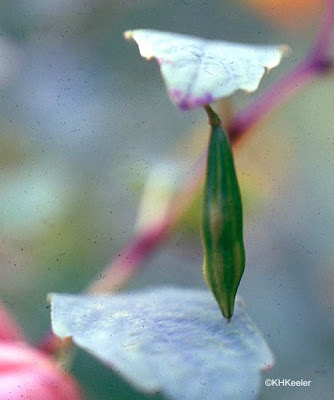Spring brings memories of childhood. We lived in upstate New York (Scotia, near Schenectady) and behind the house was a forested hill, belonging to an owner who lived somewhere on the far side of it. At our edge, a stream wove through the lowest areas, making marshy ground under the willows. Jewelweed grew abundantly in that area.
 |
| A wet area with many jewel weed plants |
 |
| jewelweed, Impatiens capensis |
There are two jewelweed species in the eastern United States, spotted jewelweed (Impatiens capensis) and pale jewelweed (Impatiens pallida). Their ranges broadly overlap but spotted jewelweed has orange (or reddish, or white) flowers with distinct spots on the lips while pale jewelweed's flowers are yellow and lack spots. Pale jewelweed also has narrower leaves than spotted jewelweed.
Three other species are native to the Pacific Coast. Four more jewelweed species found in the United States were introduced from Eurasia. In the whole world, Impatiens has 1,000 species, spread all over Eurasia and Africa, with just the 5 North American natives and no South American species. They are in the touch-me-not or jewelweed plant family, Balsaminaceae, which has 1001 species, because there is only one genus besides Impatiens, Hydrocera, and there is only one species of Hydrocera, Hydrocera triflora, which is native to south Asia.
The name Impatiens is based on the fruit. It is impatient. Well, impatiens means impatient. The ripe fruits pop when touched, throwing the mature seeds away from the parent plant. This gives the plant its common name touch-me-not. Dispersing seeds by flinging them with a catapult mechanism is an uncommon way of spreading seeds, but occurs here and there in the plant kingdom. (Several common American spurges, genus Euphorbia and Croton, use this dispersal method.) Jewelweed was the first plant I knew that did it, and so by late summer, whenever I was near them, I'd search out the ripe pods and touch them. Twang! and the seeds were gone. For me the name was Touch Me!, not touch-me-not.
 |
| Pulling down a jewelweed leaf to show the ripe fruit (the pink blob is my thumb) |
 |
Except that jewelweed is a plant of soggy soils and deep shade. So watching for pollinators you might get your feet soaked, and the mosquitos will likely find you. For me, the close encounters with hummingbirds more than balanced a few mosquito bites.
The plants are soft and moist and their sap is orangy. The crushed plant is a folk medicine for treating skin irritations, from stinging nettles to poison ivy. Native Americans used it to treat nettles and poison ivy but also skin problems of all kinds, including rashes and burns. Scientific experiments testing a mash of the leaves found that that treatment did reduce dermatitis from poison ivy although the juice by itself was not shown to be effective.
 |
Comments and corrections welcome.
References
Borge, M.A. 2016. Jewelweed has a backup plan. Thenaturalweb.org link Wonderful photos of pollinators.
Fernald, M. L. 1970. Gray's Manual of Botany. 8th edition. D. Van Nostrand Company, New York. Good source on meaning of plant scientific names.
Moerman, D. E. 1998. Native American Ethnobotany. Timber Press, Portland, OR. Online database
Motz, V. A., C. P. Bowers, L M. Young, D. H. Kinder. 2012. The effectiveness of jewelweed, Impatiens capensis, the related cultivar I. balsamina and the component, lawsone in preventing post poison ivy exposure contact dermatitis. Journal of Ethnopharmacology. 143(1): 314-318. link
Zink, B. J., E. J. Otten, M. Rosenthal and B. Singal. 1991. The effect of jewel weed in preventing poison ivy dermatitis. Journal of Wilderness Medicine. 2: 178-182. (online as download)
Kathy Keeler, A Wandering Botanist
More at awanderingbotanist.com
Join me on Facebook: https://www.facebook.com/AWanderingBotanist


No comments:
Post a Comment